
Merope, designated 23 Tauri, is a star in the constellation of Taurus and a member of the Pleiades star cluster. It is approximately 440 light-years (135 pc) away.

UU Aurigae is a carbon star in the constellation Auriga. It is approximately 341 parsecs from Earth.
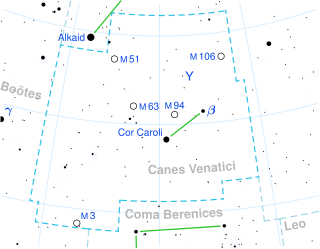
La Superba is a strikingly red giant star in the constellation Canes Venatici. It is a carbon star and semiregular variable.

Gliese 105 is a triple star system in the constellation of Cetus. It is located relatively near the Sun at a distance of 23.6 light-years. Despite this, even the brightest component is barely visible with the unaided eye (see Bortle scale). No planets have yet been detected around any of the stars in this system.

Zeta Cephei is a star in the constellation of Cepheus. Zeta Cephei marks the left shoulder of Cepheus, the King of Joppa (Ethiopia). It is one of the fundamental stars of the MK spectral sequence, defined as type K1.5 Ib.
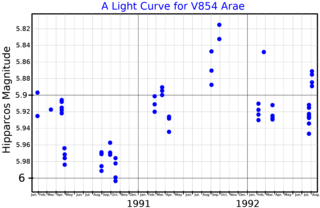
HD 155035 is the Henry Draper Catalogue designation for a star in the constellation Ara, the Altar. It is located at a distance of approximately 1,450 light-years from Earth and has an apparent visual magnitude of 5.92, making it is faintly visible to the naked eye. This is a red giant star with a stellar classification of M1.5 III. It an irregular variable that changes brightness over an amplitude range of 0.12 magnitudes.

NO Aurigae is a pulsating variable star in the constellation Auriga. It is an unusually-luminous asymptotic giant branch star about 3,500 light years away.

W Andromedae is a variable star in the constellation of Andromeda. It is classified as a Mira variable and S-type star, and varies from an apparent visual magnitude of 14.6 at minimum brightness to a magnitude of 6.7 at maximum brightness, with a period of approximately 397.3 days. The star is losing mass due to stellar winds at a rate of 2.79×10−7M☉/yr.

V4381 Sagittarii is a variable star in the constellation Sagittarius. A white supergiant of spectral type A2/A3Iab, it is an Alpha Cygni variable that varies between apparent photographic magnitudes 6.57 and 6.62. Its visual apparent magnitude is about 6.54.

1 Camelopardalis is a double star system in the constellation Camelopardalis. Its combined apparent magnitude is 5.56 and it is approximately 800 parsecs (2,600 ly) away.

R Equulei is a class M Mira variable star in the constellation Equuleus. Its brightness varies between a minimum magnitude of 15.0 to a maximum of 8.7 with an average period of 261 days.

Sigma Ophiuchi, Latinized from σ Ophiuchi, is a single, orange-hued star in the equatorial constellation Ophiuchus. Its apparent visual magnitude is 4.31, which is bright enough to be faintly visible to the naked eye. The annual parallax shift of 3.62 mas as seen from Earth provides a distance estimate of roughly 900 light years. It is moving closer to the Sun with a radial velocity of −28 km/s.

Y Centauri or Y Cen is a semiregular variable star in the constellation of Centaurus.
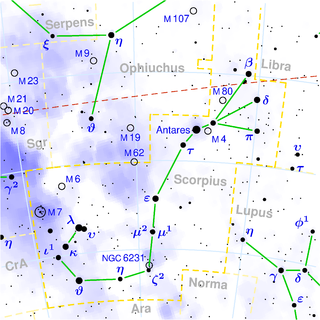
AH Scorpii is a red supergiant variable star located in the constellation Scorpius. It is one of the largest stars known by radius and is also one of the most luminous red supergiant stars in the Milky Way.

V3903 Sagittarii is an eclipsing binary star system in the constellation Sagittiarus. It creates an H II region LBN 29 1,070 parsecs away from the Sun.
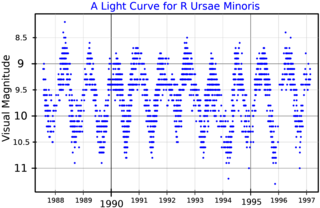
R Ursae Minoris is a star in the constellation Ursa Minor. A red giant of spectral type M7IIIe, it is a semiregular variable ranging from magnitude 8.5 to 11.5 over a period of 325 days.

AC Herculis, is an RV Tauri variable and spectroscopic binary star in the constellation of Hercules. It varies in brightness between apparent magnitudes 6.85 and 9.0.
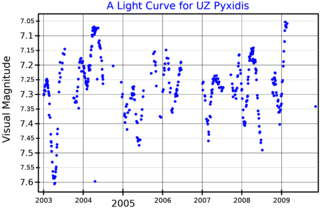
UZ Pyxidis is a semiregular variable star in the constellation Pyxis. It is located about 3,600 light-years away from the Earth.
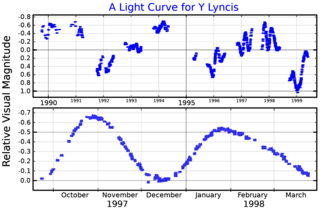
Y Lyncis is a semiregular variable star in the constellation Lynx. It is an asymptotic giant branch star of spectral type M6S, with a luminosity class of Ib, indicating a supergiant luminosity. It is around 1,160 light years away.

RY Tauri is a young T Tauri star in the constellation of Taurus about 450 light years away, belonging to the Taurus Molecular Cloud. It is more massive than typical T Tauri stars, and may be an intermediate between this class and the Herbig Ae/Be star type.




















